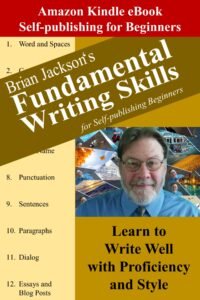The proper use of paragraphs is an essential skill if you are to become a proficient writer. Unfortunately, most of my students don’t know how to properly use a paragraph and therefore often don’t. This is not the fault of my students’, but rather my own failing in not stressing proper paragraph usage… until now!
Here then are my three rules for inserting paragraph breaks.
1 Group Sentences by Related Topic
Rule 1: Sentences should be grouped into paragraphs when sentence topics are related.
For example, I recently received this student writing submission:
Traditional publishing begins with the lengthy process of finding a decent agent to represent you. In most cases, your agent will be a useless sponge to whom you pay 15% of your revenue; but if you get lucky, they will eventually find you a publisher. Congratulations, you’ve just acquired two new bosses. My wife, Melanie Jackson, published with the New Your publishing house Dorchester Publishing for ten years. Before that, she spent four years writing while looking for an agent. In the end, she chose to self-publish her future work rather than stick with New York. The following is an explanation for this decision. One of the first things that Melanie encountered after joining Dorchester was that she now had two new bosses: her agent and her content editor. Her agent insisted on reviewing her work and even refused to represent work that the agent didn’t deem worthy. In the meantime, her content editor provided additional editorial feedback which was often difficult for Melanie to accept. During her time with Dorchester, Melanie managed to have two books published per year. She could have written faster than that, but two books a year was the most that Dorchester could accept. Ultimately, she averaged approximately $10,000 per year in royalties publishing her two books. When Dorchester closed its door in 2000, Melanie found herself out of a job. Based on my success self-publishing a handful of books, I was able to convince Melanie to join me in self-publishing her new line of cozy mysteries. During the next five years, we managed to publish over 100 books and made approximately $500,000. The following are some things to consider before choosing a publishing path.
The is a daunting paragraph. I would break it into multiple paragraphs simply to avoid overwhelming the reader even if all the sentences were related to a single topic. But they’re not all related. This single paragraph discusses seven widely disparate topics and should therefore be divided into seven paragraphs as follows:
Traditional publishing begins with the lengthy process of finding a decent agent to represent you. In most cases, your agent will be a useless sponge to whom you pay 15% of your revenue; but if you get lucky, they will eventually find you a publisher. Congratulations, you’ve just acquired two new bosses.
My wife, Melanie Jackson, published with the New Your publishing house Dorchester Publishing for ten years. Before that, she spent four years writing while looking for an agent. In the end, she chose to self-publish her future work rather than stick with New York.
The following is an explanation for this decision.
One of the first things that Melanie encountered after joining Dorchester was that she now had two new bosses: her agent and her content editor. Her agent insisted on reviewing her work and even refused to represent work that the agent didn’t deem worthy. In the meantime, her content editor provided additional editorial feedback which was often difficult for Melanie to accept.
During her time with Dorchester, Melanie managed to have two books published per year. She could have written faster than that, but two books a year was the most that Dorchester could accept. Ultimately, she averaged approximately $10,000 per year in royalties publishing her two books.
When Dorchester closed its door in 2000, Melanie found herself out of a job. Based on my success self-publishing a handful of books, I was able to convince Melanie to join me in self-publishing her new line of cozy mysteries. During the next five years, we managed to publish over 100 books and made approximately $500,000.
The following are some things to consider before choosing a publishing path.
2 Break Up Large Blocks of Text
Rule 2: Insert paragraph breaks just to break up very long paragraphs to make your text more reader accessible.
Break your text into paragraphs of no more than six sentences. Don’t insert paragraph breaks at random, but rather insert them where readers would probably need and expect a break. Notice how the text in the previous example became much easier to read once broken into multiple paragraphs.
3 Write Dialog and Mix It with Narrative
Rule 3: Insert paragraph breaks between speakers of dialog and when switching between dialog and narrative unless inserting a short single sentence of narrative.
For example:
“Hello, Rudy,” Ted said.
“Hello, Ted,” Rudy replied. “I can’t help but notice that you’re not wearing any pants. Is that intentional?”
“Oh, good Lord, you’re right!” Ted retorted ashamedly.
Ted was one known for forgetting the routine things in life. At least he hadn’t managed to forget his name, Rudy ruminated.
And that’s it for my 3 rules for paragraph break insertion.
I’ll see you in the classroom,
—Brian


















